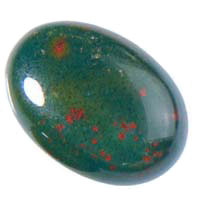

An ancient gemstone, bloodstone, also known as heliotrope, has had many mystical properties attributed to it. These properties run the gamut from healing to invisibility to altering the sun. Comprised of green jasper and red spots of iron oxide or hematite, appearing to be spots of blood, bloodstone was believed to have originated when the blood of Christ spilled to the ground as he was crucified. In the ancient world bloodstone was used as signet seals and in jewelry, as well as being carved into decorative cups, small vases and statuettes. Today bloodstone is still used in jewelry but also used in modern crystal healing and as the Base, or Root Chakra controlling the energy for kinesthetic feeling and movement.
| Chemical Formula | SiO2 | Mineral Class | Quartz (Chalcedony) |
|---|---|---|---|
| Color | Red, Green, Brown, Multicolored | ||
| Crystal System | Opaque | Hardness | 7 |
| Transparency | Vitreous | Luster | luster |
| Refractory Index | 1.544 - 1.553 | Double Refraction | 0.009 |
Heliotrope (bloodstone) was called "stone of Babylon" by Albertus Magnus, German monk and alchemist, and he referred to several magical properties.
According to the ancient experts of magic, bloodstone (heliotrope), when combined with the herb heliotrope, and with the help of certain incantations, so dazzles the eyes of men that it causes the bearer to be invisible.
Pliny the Elder (1st century Roman author and naturalist) mentioned that the magicians used bloodstone as a stone of invisibility.
Damigeron (4th century author) wrote about bloodstone’s ability to make rain and solar eclipses and its special virtue in divination and preserving health and youth.
The most widely known legend of this stone comes from the middle ages and claims the “blood stone” was formed at the crucifixion of Jesus Christ, when the blood of his wounds fell onto the dark green earth and turned to stone.
Another version says that the blood of Christ, which flowed from the fatal spear-thrust, fell upon jasper lying at the foot of the cross, and from this sprang the bloodstone variety of jasper.
Bloodstone was treasured long before the time of Christ, known in antiquity as heliotrope, the sun stone. Ancient legends say that when bloodstone was placed in the rays of the setting sun, or immersed in water, it turned the reflection of the sun to blood-red.
Ancient Roman soldiers believed that the stone had the ability to slow bleeding and wore it for this reason.
A superstition in India holds that bleeding can be staunched by placing bloodstone upon wounds and injuries after dipping it in cold water. This may possibly have a scientific basis because iron oxide, contained in the stone, is an effective astringent.
In many cultures, bloodstone was dipped in cold water and placed on the body to aid circulation and transfer the power of the sun to prevent injury or disease, stop the flow of blood, or cure any wound.
The Gnostics wore the stone as an amulet for longevity, wealth, and courage, and to strengthen the stomach as well as dispel melancholy.
Bloodstone was considered useful for animal husbandry in the middle ages.
Ancient Greeks and Romans wore bloodstone to bring distinction, favor, and endurance as well as a charm against the bite of venomous creatures. Greek and Roman athletes also preferred it as talisman for success in their games.
Bloodstone has been regarded as a gem of noble sacrifice that can offer courage and solace to all who are called to give of themselves for the good of others. It has also been believed to elicit the highest, most altruistic character of those who wear or carry it.
Bloodstone’s use for healing, and its connection to blood and detoxification of the organs, dates back five thousand years to Mesopotamia.
Ground, powdered, and mixed with honey, bloodstone was used to cure tumors, draw out snake venom and staunch hemorrhages. It was also said to clear putrefaction of abscesses in a day, and simply looking at the stone was believed to prevent eye diseases.
Today many believe bloodstone to be a lucky charm and it is prized by athletes and others who want to grow their strength.
Even in modern day India, fine bloodstones may be crushed into a powder and used as an aphrodisiac.